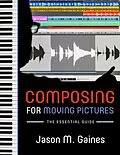Making quality moving pictures has never been easier or more affordable, and the proliferation and ease of access to digital recording devices has prompted scores of amateurs to record and post videos to YouTube and its ilk. Paradoxically, however, scoring and arranging music for motion pictures is, in many ways, more complicated now than ever before, requiring extensive knowledge of notation, arranging, recording, and mixing software and multi-component DAW workstations. In Composing for Moving Pictures: The Essential Guide, author Jason Gaines offers practical tools with which to navigate the increasingly complex environment of movie music composition. He addresses both the principles of composition for moving pictures and the technologies which drive music composition, performance, and recording in an integrated and comprehensive fashion. The guide takes readers from square one - how technology can facilitate, rather than hinder, creativity in scoring - and then moves into the basics of working with MIDI files and on to more advanced concepts such as arranging and mixing. Gaines illustrates each step of the process with screen shots and explanations in the form of program tutorials. Composing for Moving Pictures fills a hole in literature on film scoring in the digital age and will prove to be an invaluable resource for music educators at the university and secondary level. Amateur composers will also delight in this easy-to-use guidebook.
Autorentext
Jason Gaines is a New York City based trumpet player, composer, educator and author. His career spans studio recordings, Broadway productions and live performances with his own quintet, the Jason Gaines Group. In addition to his performance career, Jason has had a long career in education, teaching in various settings that span K-12, college, and adult education. He holds degrees from the Manhattan School of Music, New York University and Teachers College, Columbia University.
Inhalt
Acknowledgements Part I 1. A Brief History of Film 2. The Digital Audio Workstation 3. Recording and Editing Audio 4. Recording and Editing MIDI 5. To Loop or Not to Loop - An Exploration of Loops, Beds and Foley 6. Working with Videos 7. Music Creation on Mobile Devices and an Introduction to Basic Mixing 8. Delivery, Collaboration and Archiving 9. Best Practices and Troubleshooting Part II 10. Terence Blanchard 11. Marc Shaiman 12. Steve Horowitz 13. Nathan Barr 14. Trevor Morris
